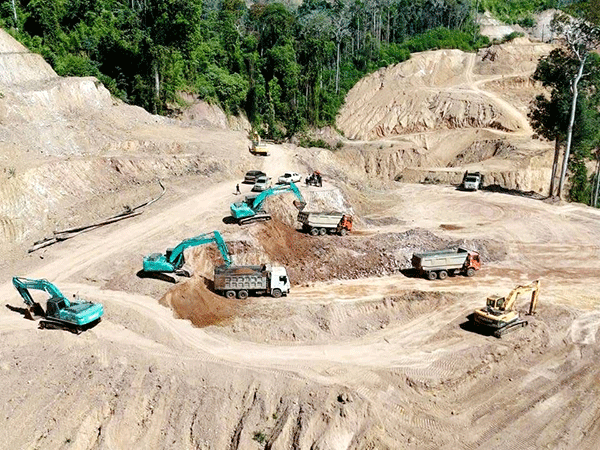 |
| Diggers carve out a section of the Vientiane-Hanoi expressway, running from Pakxan to the Vietnamese border. |
Road crews begin work on Section 2 of Vientiane-Hanoi Expressway
Construction of the Vientiane-Hanoi Expressway has entered a new phase, with work on Section 2, stretching from Pakxan district in Bolikhamxay province to the Vietnamese border, already underway.
Noticeable progress has been made following the signing of a contract last month, when the contractor, the Namtha Construction-Bridge-Road Sole Co., Ltd. Group, deployed personnel and heavy machinery along the 203.8-kilometre route.
According to a technical field technical employed by the company, Mr Bounta Sengkamfong, teams have begun work starting at Km0 in Thong village, Pakxan district, with other work in progress on the Km22, 33-34, and 96-106 sections in Viengthong district.
Right-of-way clearance is currently the main priority, in preparation for full-scale construction.
Concurrently, Deputy Head of the Vientiane-Hanoi Expressway Construction Project for Sections 1 and 2, Mr Lienethong Vonghachak, said the contractor has demonstrated strong commitment to the project. Machinery has been stationed at all designated construction points to ensure work moves forward on schedule.
The contractor aims to complete Section 2 of the expressway by the end of 2029, through the simultaneous execution of three project components: earthworks, structural works, and road surface paving.
Machinery will be deployed every 10-20 kilometres, with bridge construction progressing concurrently across all locations. Concrete paving will be laid in flat areas where earthworks have already been completed.
A temporary detour road will be built prior to the main roadway, and foreign workers will be brought in to enhance construction efficiency.
Section 2 of the expressway is regarded as a strategically critical component of Laos’ connectivity plans.
Positioned between Thailand and Vietnam, the route will form a key segment of a major land-transport corridor linking India, Europe and ASEAN with China, Korea, and Japan.
Currently, most cargo between these regions is transported by sea through Singapore, with roughly 100,000 vessels carrying goods worth an estimated US$1 trillion annually.
Once completed, the expressway is expected to divert a significant portion of this maritime traffic to land transport.
The land route between Thailand’s Ranong Port and Hong Kong—approximately 3,000 kilometres—is about 1,000 kilometres shorter than the existing 4,000-kilometre sea route via Singapore.
This shift is anticipated to significantly reduce transport time, cut logistics costs, and enhance cargo safety.
With Thailand and Vietnam already advancing railway and expressway connections up to their respective borders, Laos stands to gain substantial strategic benefits once Section 2 is completed.
National economic revenue is projected to increase by more than US$1 billion annually, driven by foreign and domestic investment, trade, tourism, and logistics services.
The arterial highway is also expected to enhance national security and strengthen Laos’ role as a regional transport hub.
By Times Reporters
(Latest Update November 28, 2025)
|


